All About The Money: Authors, Readers, and Ebook Prices
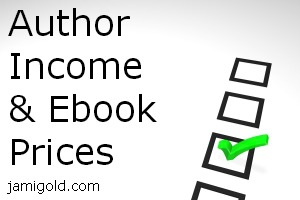
The publishing world has been abuzz with the results of the 2014 Digital Book World (DBW) and Writer’s Digest Author Survey. Headlines scream “Most authors make less than $1000 a year.” Numbers taken out of context claim that 80% of the 9000+ respondents earn $1000 or less.
Eh. Yes and no.
Yes, the DBW/Writer’s Digest survey polled 9,210 or so writers. However, don’t let that big number impress you so much that you assume this survey data is uber-accurate. More than 65% of those respondents are “aspiring” and haven’t published anything yet.
The DBW/Writer’s Digest Survey Results
According to The Guardian, the remaining respondents broke down to “18% self-published, 8% traditionally-published and 6% saying they were pursuing hybrid careers.” Okay, so that leaves around 3000 respondents who have been published in some way, shape, or form.
But wait, a full 20% of both the self-published and the traditionally published respondents said they’ve made $0. Ditto with 5% of the hybrid authors. And yes, that means literally zero dollars, as the next income band goes from $1 to $999.
I find that result odd. Does that mean zero income from book sales? Or zero income after expenses?
I don’t know, but it does make me suspect the question wording and/or the respondent base was a bit hinky. Maybe those authors are planning on self-publishing, or maybe they have a traditionally published book that hasn’t been released yet. Or maybe the DBW/Writer’s Digest respondent base doesn’t reflect professional published authors.
Many have criticized the survey because it was run by Writer’s Digest, who’s been known to recommend vanity publishers to those interested in self-publishing. If the respondents were from the vanity publishing arena, then yes, I could see their income being zero (or negative).
Brenda Hiatt’s Survey Results
Anyone who has studied the industry knows that one book alone isn’t going to cut it. Professional authors, those that treat their writing as a career, focus on building a backlist. If we have 3-6 books out, it doesn’t take much income from each to break $1000.
A look at Brenda Hiatt’s amazing site “Show Me the Money” lists the advance, royalty rates, and earn out for various romance and YA traditional publishers. The vast majority of earn out amounts on her site are over $1000, so even if an author publishes only one book a year, they’d still beat that DBW figure. And Brenda’s gathered data from almost 2700 traditionally published titles.
Now, that’s not to say her respondents are rolling in the dough. The average advance or earn out probably works out to around $10K, with some as low as $200.
My point is that I don’t quite trust DBW’s results. But I’m not going to pay nearly $300 for the full report to analyze how the heck they came up with their numbers. The results strike me as “link bait” in their attempt to sell copies of their report.
Beverley Kendall’s Survey Results
We all know some self-published books are crap. I’ve seen them. I’ve talked to their authors. And they plain don’t care. They’re in it for the quick buck, or they believe they’re geniuses who don’t need editing.
That’s why I was far more interested in the results of Beverley Kendall’s survey of self-published/hybrid authors. Some self-publishers obtain professional-level editing and covers, and that group should be more comparable to traditionally published authors. Beverley asked the questions that really matter rather than lumping all self-published authors together.
She analyzed results from her 822 self-published respondents, and 65% of her respondents had no previous traditional or epublishing deals to improve their name recognition. Keep that in mind for these results. (And I highly recommend checking out her 29 page, free report of her analysis at the link above. Fantastic information!)
How Off-Base Is the DBW Survey?
First thing I note (page 4), 48.05% earned over $10,000 in 2013. Even with no traditional publishing name recognition, 46.04% of self-published-only authors earned over $10K. Hmm, that’s quite different from the 5% for self-published-only authors earning those numbers in the DBW report.
The second thing I note (page 10) is that backlist really matters. While 80% of respondents with 1-3 books for sale make $10K or less, that figure drops quickly with additional books. About 50% of respondents make more than $10K when they have 4-7 self-published books available, and 20% make more than $50K. At 12-20 books available, over 50% of respondents are making 50K or more, and 30% are over $100K.
How Much Does Professionalism Matter?
Now let’s look at those numbers for professional, self-published authors—that is, those who use a professional editor and cover artist (page 13). Of those who didn’t use a professional editor (Beverley’s definition: “with a publishing background”), 40.23% earned more than $10K. In contrast, of those who did use a professional editor, 50.82% earned more than $10K.
Similarly, of those who didn’t use a professional cover artist (her definition: “graphic artist or professional designer”), 39.21% earned more than 10K. In contrast, of those who did use a professional cover artist, 52.55% earned more than $10K.
In short, professionalism matters. And the percentage differences between professional editing and professional cover design aren’t much, so they both seem to be important. However, a professional cover has a slight edge over editing if you’re dealing with limited funds.
Is Beverley Kendall’s Survey the Anomaly?
Brenda Hiatt’s “Show Me the Money” page surveys self-published authors too. For 2012, her respondents averaged 10 titles each (that backlist mentioned above) and averaged $137K. The median, which discounts outliers better, was still $51K.
Those figures match Beverley’s 2013 results for authors with similarly large backlists. So I think it’s safe to say that for those authors who approach self-publishing as a career (build a backlist, use professional editors and cover artists, and other things I’ll probably go into in another post), making more than $1K a year is the norm.
Jami Gold’s Ebook Reading Habits Survey Results
A couple of weeks ago, I ran my own survey poll questions about ebook prices and our reading habits. I knew from my own Kindle that I have far more books in my to-be-read pile than I have time to read, so I wondered if ebook prices affected whether we’d actually get around to reading a book.
Note: I received 666 responses. (Yes, really. *dodges lightning bolt*) Click on the images to see full size. Also, if you’re reading from my newsletter, click through to the post to view all the images.
At This Price, I Won’t Try Them because They’re Crap
We’ve heard some rumblings that books priced free or $.99 might give the impression of crap, so that was my first question. As expected, free came out on top, followed by $.99 and $1.99 in the top 4 answers.
But what I found interesting was that the third place answer was “Other,” and many of those “Other” answers emphasized that they judge by sample chapters not by price, etc. So while expectations are lower for cheaper books, that price doesn’t necessarily condemn them to a won’t-try-them ghetto.
At This Price, I’ll Buy Them But Won’t Be in a Hurry to Read
However, in this question, we see that readers won’t usually be in a hurry to read anything free or $.99. Even $1.99 and $2.99 don’t trigger the “I have to read this now to make sure I don’t waste that money by letting it get buried in my Kindle” attitude.
What’s equally interesting are the zero responses for $5.99-$8.99. At that price, any readers who pay that amount are bound and determined to prevent the book from being buried.
At This Price, I’ll Read Them and Have Higher Expectations
Here, we see that books between $4.99-$7.99 have high expectations and are still priced for readers to buy. $2.99 and $3.99 sit in a middle position, where some readers have higher expectations and some don’t. The $8.99 and $9.99 results reflect that ebooks at that price are too expensive to buy unless we already know and love the author.
At This Price, I’ll Buy Them because I Know I Love Them
Here, we see that if we know we love an author, we’re willing to pay between $4.99 to $9.99 and above. I was surprised by the highest results at the $6.99 and $7.99 prices, but if my choice for a beloved author was that price for an ebook or an over-$10 print book, I might go for the ebook version as well. *smile*
At This Price, I Won’t Buy an Ebook because It’s Too Expensive
No surprise that “$9.99 and above” far surpassed the other answers, yet at the same time, in the “Other” comments, about 12% of the respondents said they’d be willing to pay about $15 (or more) for an ebook. Before celebrating that 12%, note that about 15% of the respondents said anything $5.99 or over would be too expensive.
I think that confirms what many authors have suspected: $2.99-$4.99 is the “sweet spot” for ebook pricing. Those prices don’t trigger readers’ “too expensive for an ebook” attitude, and about 40% or more of readers would have high enough expectations to actually read them.
In addition, Beverley Kendall’s survey shows that for those authors making $25K or more a year, virtually all of their top-earning books are in that same $2.99-$4.99 sweet spot (page 14). In fact, the only authors that have their best-earning book at $.99 or $1.99 are those making $10K or less a year.
Which direction does that causation flow? Is it a quality-yet-underpriced book leading to low earnings? Or is it a low-earning author not having enough quality to charge more for their books? I don’t know, but it’s interesting food for thought. *smile*
Had you heard about all these surveys? Did you take part in any of them, and if so, which ones? What do you think about the DBW vs. the Beverly Kendall/Brenda Hiatt results? Do you have thoughts for why their results would be so different? Do you have any questions or comments about my Ebook Reading Habits Survey?
Pin It
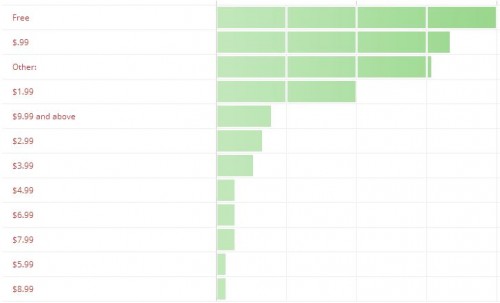

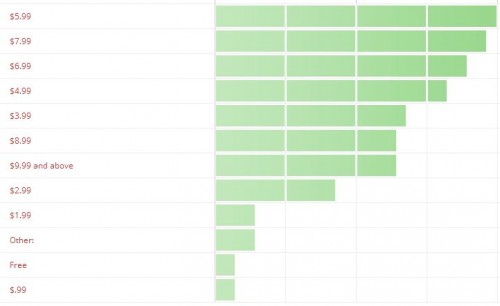
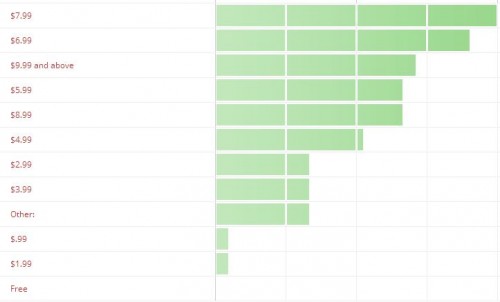
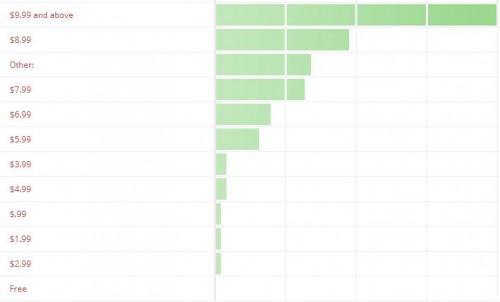
Something is definitely fishy about the DBW survey. First that it counted aspiring, unpublished writers with the professionals—what industry counts the trainees with the professionals, when surveying income?. And second… Well, let me point out some numbers.
80% of survey respondents made ≤$1k, which means 20% of survey respondents made >$1k
>65% of survey respondents had nothing published, which means <35% of survey respondents had something published
And yet a quarter of those with things published made nothing, and about half more than $10k. Which puts only about a quarter in the middle.
Which actually supports Kris Rusch and Dean Wesley Smith’s claim that the best promo is to write the next book and have a backlist.
And to finish my thought, what’s fishy isn’t that the data supports DWS and KKR. What’s fishy is how they skewed their own numbers so they could have that headline that doesn’t actually fit the pertinent data.
Hi Carradee,
Yes, that “What Advantages Do Traditional Publishers Offer Authors” title on the graph of that MB/GC article I linked to above apparently came directly from DBW/WD’s survey. That’s a very leading concept–hence my suspicion of link bait to sell copies of the report. 🙂 Thanks for the comment!
Hi Carradee,
Yes, the numbers that are getting reported out of context don’t make any sense. The MediaBistro/GalleyCat article about the survey includes graphs that I assume are from the report. Those graphs make it clearer that the 80% number applies to self-published authors and not aspiring. But those graphs also claim the zero income for 20% of both self-pub and trad authors, which makes ZERO sense to me. 🙂 Thanks for the comment!
So in other words, what doesn’t make sense are the numbers altogether reported—in context, out of context, or despite the context.
😀
(Couldn’t resist.)
Hi Carradee,
*snort* Yep, that’s about it. 😉
LOOK AT ALL THE DATA!!!! GLORIOUS DATA!!!! *rolls in data*
Um–ahem. Um. Yes. Insightful analysis. So glad to have a voice of reason and critical thought here. 😉 Can’t wait to dig in more.
Hi Jordan,
LOL! I know! I about drooled over Beverley’s report. 🙂 Thanks for the comment!
Awesome breakdown… Me, I’m not expecting to be rolling in dough – I’m building a backlist because I want to have lots of books out there… and having professional editing / covering because I want what’s out there to be good! Of course, I do very want to be bought and read – and getting rich and famous would be a bonus 😀 It’s great to have an idea of what kind of pricing brings out what kind of response!
Hi Sara,
Yes, I’m not looking to quit my day job, but extra income would be nice. For me, these results confirm a lot of what I’ve been building my strategy toward, so that’s good to know. 🙂 Thanks for the comment!
Just about every time I read something that goes against the ‘sweet spot – $2.99-$4.99’ pricing, I dig a little and find that something doesn’t add up.
So, the question begs, other than the obvious, which is to make more money off of gullible authors, what is the reasoning behind producing this information-that-isn’t-quite-disinformation-but-not-really-accurate reports?
Hi Widdershins,
I don’t know–isn’t the obvious enough? 😉 Thanks for the comment!
Hi Jami,
Statcounter is a beautiful thing. LOL.
But I’m glad you found value in my survey.
I’ll say this of the Writer’s Digest survey, of the 2947 respondents who they said actually self-published a book, I wonder which category they’d fall into in my survey.
Were most of them non-fiction writers? How many of them were trying to self-publish Children’s picture books or poetry? How many books did they have out? How long had they been self-publishing? What genre did they write? And the list goes on. If I saw THOSE facts, and if it confirms what I think, I wouldn’t be the least bit surprised to discover almost 80% of them didn’t make more than $1000 a year.
If my respondents fell in the have 1-3 self-published books out range, my results would say that almost 80% of those authors earned $0-$10k.
But I won’t be spending $295 to get the full report. 😉
Thanks again
Bev
Hi Beverley,
Yay! Thank you so much for coming by. 🙂 Your report was fantastic! I’m still in awe of all that information.
Yes, I could see a fair number of DBW/WD’s respondent base falling into many of those categories. As you stated in your Facebook post, there are some known strategies for self-publishing in a professional and successful way, and lumping all self-published authors together only dilutes those lessons. That’s partly why I loved your report so much. You really make those lessons clear and easy to understand.
Thank you again for all you’ve contributed to our understanding of the issues and thanks for the comment!
I’m so glad there’s people out there willing to crunch numbers so I don’t have to. *runs away screaming from even the thought of math*
Hi Amber,
Oh my gosh, math is not my strong suit, so I kept putting off writing this blog post. Um, I finally finished it at 2 a.m. *head desk* I hope it helps. 🙂 Thanks for the comment!
As a fellow math phobic I empathize with what it took to do this post, Jami. That said, this post was sobering to read, even knowing the math doesn’t entirely add up, what does seem clear is that the biggest barriers of self-publishing remain cover design and outside editors. Things some of us just can’t afford yet. Which isn’t the same is saying “I’m so great. I won’t need that.” You once said commenting on my reply to a previous post that beta readers can still be helpful, but how do you discern what’s helpful or not, because especially with non-writers or writers who don’t write what you do, there can be a LOT of “Preference disguised as Practical advice. You once said commenting on my reply to a previous post that beta readers can still be helpful, but how do you discern what’s because especially with non-writers or writers who don’t write what you do, there can be a LOT of “Preference disguised as Piratical advice.” For example, I’m not a fan of gross out humor, but I won’t mark it up and say “DELETE!” because while I’m averse to gross out humor, many love it (Especially in kid lit where I hang out most) but if it’s meant to be there, fine, but I’m a more open beta-reader in matters like this. Especially when I’m desperate for an outside persepctive and swap with someone. Some of my favorite books do enter the “Gross Zone” at times, but not… — Read More »
Hi Taurean, Yes, that’s a good point about the real “barriers to entry” for successful self-publishing. That said, notice that over a third of those authors who didn’t have a professional editing or cover still had some measure of success. So it’s not that success is impossible under those circumstances by any means–it’s just 10% or so harder. As far as your question about beta readers and their preferences, that issue can certainly crop up. We can overcome the issue by using multiple beta readers (do several have issues with it or just one?) and ensure that about 1/2 to 2/3 of them are in our genre, so they already understand what does and doesn’t work. I’m still a slow writer, and I don’t see myself being able to speed up by a lot anytime soon. Because of that, I’ve adjusted my strategies and expectations. I’ll eventually get a backlist of 12 books, but it might take me a lot of years to get there. 🙂 That’s only a problem if I expect magic to intercede. Instead, I know my limitations and I adjust my expectations accordingly. That’s a great question about how slow writers can build a backlist. Remember that all releases we have available (like on Amazon) are our backlist. That can include short stories, novellas, short stories in anthologies with other authors, etc. So I’m looking at the possibility of rounding out my releases with shorter lengths in addition to the novels. I can get a short… — Read More »
What a wonderful job of not only taking those numbers and stats and breaking them down, but also of laying them out in a way that makes sense to everyone. I admit it. Crunching numbers is my kryptonite. Thanks for taking the time to share your findings in a way that I understood.
Hi Kitt,
LOL! I don’t claim to be any better with numbers. 🙂 Luckily others had already done most of the heavy lifting as far as gathering the data. I hope it’s helpful! Thanks for the comment!
Thanks so much for pulling all these different surveys and stats into one very easy to understand blog post, Jami. You’re a star!
Hi Romy,
Aww, thanks. 🙂 I hope this is helpful. Thanks for the comment!
[…] (Note: Polls are now closed and the results are listed in this post about author income and ebook prices.) […]
FAN-BLOODY-TASTIC info here, Jami!!
I’ve never heard of these surveys, but to me, the Beverly Kendall/Brenda Hiatt results seem much more intriguing than the DBW. And, um, yeah, 300 clams…why don’t they just ask for a pint of blood to boot for the remainder of the info.
I can’t wait to click on the links you added!
LOVED THIS 🙂
Have a great afternoon!!
Tamara
Hi Tamara,
LOL! Yes, we can learn so much from Beverley’s report about what business strategies work. 🙂 Thanks for the comment!
Thanks for taking the time to compile all these numbers into something I can easily digest. I will be sharing this!
Hi C.B.,
I’m happy to help. 🙂 Thanks for sharing and for the comment!
[…] this professional-author path sounds like you, study the lessons we can learn from others. Weigh the strategies others have tried and come up with a plan that matches your […]
[…] who have one book, and authors who haven’t published in the recent past. On both sides. Jami Gold then broke that down, again, brought by Passive […]
[…] most authors (of any type) make less than $1000 a year. Here's a good round-up of recent numbers: All About The Money: Authors, Readers, and Ebook Prices | Jami Gold, Paranormal Author Pauline M Ross: writer of epic fantasy The Plains of Kallanash and a reviewer on speculative […]
[…] on how to price your titles. While Laura Kaye goes into this a little in her post as well, Jami Gold asked her readers which price point they felt most comfortable with when it came to purchasing […]
[…] Jami Gold’s roundup of publishing/income/pricing surveys and information. […]
[…] There have been several self-publishing surveys and reports lately. Some of them are almost worthless due to bad sampling and faulty conclusions. Some have been better. Here’s a good summary of several of them: All about the Money […]
[…] a free series-related book. As we discussed in my initial posts about Beverley’s survey (here and here, and consolidated into my guest post at Kristen Lamb’s blog yesterday), offering a […]
[…] on that book, and views all her nine books (with one more coming in March). Independent author Jami Gold blogged about two more analytical reports that took apart the DBW claim about most independent authors […]
[…] on that book, and views all her nine books (with one more coming in March). Independent author Jami Gold blogged about two more analytical reports that took apart the DBW claim about most independent authors […]
[…] Over a year ago, I ran a couple of posts with insights into a survey of self-published authors. Beverly Kendall conducted a survey with questions to dig into whether self-published authors who strive for professional quality find more success. […]
[…] The survey I ran last year showed that—not surprisingly—people are more likely to read a book if they’ve paid more for it. If we’re spending $5.99 or more for an ebook, we’re going to make sure it’s not buried in our ereader. For the same reason, we’re not necessarily going to be in a hurry to read a free book. We’re simply not likely to appreciate it as much. […]